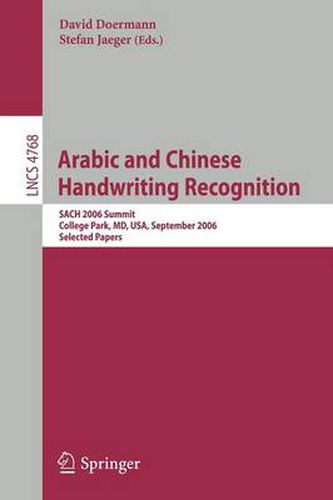Readings Newsletter
Become a Readings Member to make your shopping experience even easier.
Sign in or sign up for free!
You’re not far away from qualifying for FREE standard shipping within Australia
You’ve qualified for FREE standard shipping within Australia
The cart is loading…






This title is printed to order. This book may have been self-published. If so, we cannot guarantee the quality of the content. In the main most books will have gone through the editing process however some may not. We therefore suggest that you be aware of this before ordering this book. If in doubt check either the author or publisher’s details as we are unable to accept any returns unless they are faulty. Please contact us if you have any questions.
In the fall of 2006, the University of Maryland, along with various government and industrial sponsors, invited leading researchers from all over the world to a two-day Summit on Arabic and Chinese Handwriting Recognition (SACH 2006). The event acted as a complement to the biennial Symposium on Document Image Understanding Technology (SDIUT), providing a focused glimpse into the state of the art in Arabic and Chinese handwriting recognition. It offered a forum for interaction with prominent researchers at the forefront of the scientific community and provided an opportunity for participants to help explore possible directions of the field. This book is a result of the expansion, peer review, and revision of selected papers presented at this meeting. Handwriting recognition remains the Holy Grail of document analysis, and Arabic and Chinese scripts embrace many of the most significant challenges. We are pleased to have 16 scientific papers covering the original topics of handwritten Arabic and Chinese, as well as 2 papers covering other handwritten scripts. We asked each author to not only describe the techniques used in addressing the problem, but to attempt to identify the key research challenges and problems that the community faces. The result is an impressive collection of manuscripts that provide various detailed views of the state of research. In this book, six articles deal directly with Arabic handwriting. * Cheriet provides an overview of the problems of Arabic recognition and how systems can use natural language processing techniques to correct errors in lexicon-based systems.
$9.00 standard shipping within Australia
FREE standard shipping within Australia for orders over $100.00
Express & International shipping calculated at checkout
This title is printed to order. This book may have been self-published. If so, we cannot guarantee the quality of the content. In the main most books will have gone through the editing process however some may not. We therefore suggest that you be aware of this before ordering this book. If in doubt check either the author or publisher’s details as we are unable to accept any returns unless they are faulty. Please contact us if you have any questions.
In the fall of 2006, the University of Maryland, along with various government and industrial sponsors, invited leading researchers from all over the world to a two-day Summit on Arabic and Chinese Handwriting Recognition (SACH 2006). The event acted as a complement to the biennial Symposium on Document Image Understanding Technology (SDIUT), providing a focused glimpse into the state of the art in Arabic and Chinese handwriting recognition. It offered a forum for interaction with prominent researchers at the forefront of the scientific community and provided an opportunity for participants to help explore possible directions of the field. This book is a result of the expansion, peer review, and revision of selected papers presented at this meeting. Handwriting recognition remains the Holy Grail of document analysis, and Arabic and Chinese scripts embrace many of the most significant challenges. We are pleased to have 16 scientific papers covering the original topics of handwritten Arabic and Chinese, as well as 2 papers covering other handwritten scripts. We asked each author to not only describe the techniques used in addressing the problem, but to attempt to identify the key research challenges and problems that the community faces. The result is an impressive collection of manuscripts that provide various detailed views of the state of research. In this book, six articles deal directly with Arabic handwriting. * Cheriet provides an overview of the problems of Arabic recognition and how systems can use natural language processing techniques to correct errors in lexicon-based systems.